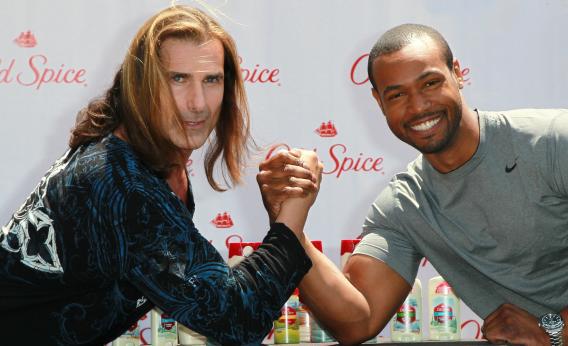Have we reached Peak Hunk? USA Today examines the trend of “sexy guys—not gals—featured in racy TV spots” since a shirtless Isaiah Mustafa first mounted a horse to promote Old Spice in 2010. In a recent ad for Kraft salad dressing, a hunk’s T-shirt spontaneously combusts when his kitchen preparation gets too “zesty” (Kraft is selling him as “The Zesty Guy”). A pair of Liquid-Plumr hunks arrive at a woman’s home to “snake her drain.” For Diet Dr Pepper, hunk Josh Button rolls around shirtless on a beach; in a Zoolandery voiceover, he announces that he is “really, really, really, really, really good looking.”
Hunks are now such a well-worn advertising trope that “the ‘surprise’ factor is kind of used up for now,” ad consultant Allison Cohen told USA Today. “Seems like it’s time for a break from this approach.” But marketers have been ramping up the use of sexual imagery in advertising over the past 30 years, and the vast majority of these ads have featured women’s bodies, not men’s. Babes are forever. Why are hunks just a passing trend?
Maybe because these advertisers are really selling jokes, not hunks. In a marketing landscape accustomed to offering up female bodies for the hetero male gaze—see 1 in 3 alcohol campaigns—these ads reverse the equation. Men performing sexuality is a “surprise” that advertisers push to absurd lengths (poof: Old Spice Man is on a boat! Salad Dressing Guy is suddenly shirtless!) to comment on the ridiculousness of the gender switch. A marketing rep for Dr Pepper defended its hunk to USA Today, saying: “We’re poking fun at ourselves and the trend of hot guys in advertising.” But the entire ad hunk trend relies on that winking attitude. When faced with a guy like Old Spice’s Mustafa, viewers can indulge in the man candy while the commercial conveniently excuses us from acknowledging that man candy as seriously sexy—and even potentially threatening. As the Old Spice ad team explained, the goal of its campaign was to create “a character who is not only loved by ladies, but equally loved by guys. A woman’s man that was okay for men to love.” (Not to mention that it may be more comfortable to poke fun at female desire than to embody it unironically.)
Of course, ad babes are also leveraged for absurd humor—take Ali Landry’s famous Doritos commercials, where the fire sprinklers spontaneously erupted from the ceiling as she chomped away at the chips, while a horde of men wagged their tongues after her. But when jokes like those get old, the babes remain. The “surprise” factor of a scantily clad woman is apparently perpetual. The real test of the longevity of the ad hunk: Will we ever take Zesty Guy seriously?
